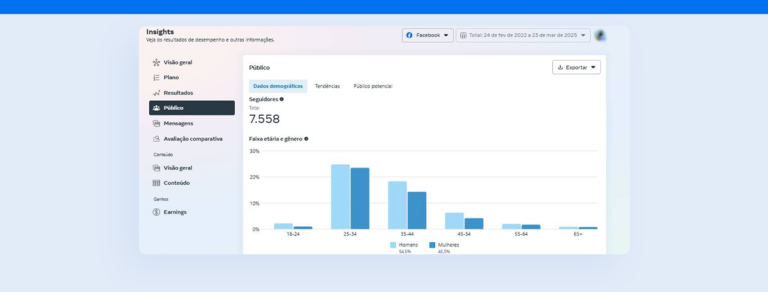Discover which sales metrics and KPIs you should monitor to grow your business
Sales metrics and Key Performance Indicators (KPIs) are vital for developing a sales team and improving overall company performance.
By tracking these data, strategic decision-making becomes more focused, communication for acquiring new clients can be better aligned, and, of course, key business objectives can be achieved.
But how do you determine which indicators are most relevant to track? In this article, we present the differences between sales metrics and KPIs (so you can better organize company results monitoring) and list the top 10 for most businesses. Let’s go?
Understanding the Differences Between Sales Metrics and KPIs
Many people think sales metrics and KPIs are the same. However, although they may be measured using the same information, they serve different purposes within a company.
While sales metrics are associated with raw performance data of the sector, Key Performance Indicators are linked to specific results that aid in achieving set goals and business development.
Sales KPIs are, therefore, essential for decision-making, defined from metrics that assist in determining more strategic paths for sales teams.
But beware: this doesn’t mean you should only analyze KPIs. Other sales metrics, individually, may not provide a complete picture of your company’s performance.
However, when evaluated collectively and especially in relation to Key Indicators, they become very relevant to understanding why you’re achieving certain results and what can be improved at each stage of the sales process.
Top 10 Sales Metrics and KPIs to Monitor
Now that you know the difference between sales metrics and KPIs, it’s time to learn about the top 10 indicators to monitor (depending on your business type, of course) and decide which will be key to achieving your goal. Check them out!
- Number of Opportunities
The number of business opportunities generated for your sales department is an important metric to monitor with your sales team and can become an essential KPI for marketing and sales departments.
Knowing the number of sales needed to maintain the company’s financial health allows you to determine the number of opportunities generated by marketing, the quantity of qualified leads, total leads, and so forth.
Moreover, when tracking opportunities, it’s also crucial to consider those lost during negotiations and use them to improve the lead capture and qualification process.
- Conversion Rate
Along with the above metric, the Conversion Rate of sales should also be evaluated. That is, the percentage of opportunities that became clients within a period. Here’s the formula:
Conversion Rate = (Number of Sales / Number of Opportunities) x 100(%)
This result not only allows monitoring of each salesperson’s performance but also provides feedback to the marketing department about the quality of generated opportunities, enabling improvements throughout the funnel.
- Revenue
In addition to tracking the total number of sales and the Conversion Rate, another important metric for your business is the total Revenue generated in a month.
A high number of sales and a significant Conversion Rate are good, but if your revenue is below what’s needed, it signals the need to review your pricing, packages, benefits, and sales strategies of products to maintain the company’s financial health.
- Average Ticket Size
Therefore, Revenue is essential for calculating the Average Ticket Size, i.e., the average amount spent by each customer. This metric is crucial for understanding how many sales are needed to meet the revenue target and can be calculated using the following formula:
Average Ticket Size = Total Revenue / Number of Sales
The result, of course, depends on the products or services offered. However, with this information, you can develop strategies to increase this average, especially if your solutions vary significantly in value.
- Customer Acquisition Cost (CAC)
Do you know how much it costs to acquire a new customer for your company? The CAC metric aims to reveal exactly that and help make your investments in marketing and sales more strategic. Here’s the formula:
CAC = Investment in Marketing and Sales (R$) / Total Number of Customers
To achieve a healthy CAC for your business, it should be lower than the Lifetime Value (LTV) — a metric we’ll explain next — or the Average Ticket Size (in the case of e-commerce, for example).
If it’s higher than either of these two results, it means you’re incurring losses and need to find ways to reduce it as soon as possible.
- Lifetime Value (LTV)
Lifetime Value measures how much a customer spends on your services while maintaining a contract with your company. To calculate it, use the formula:
LTV = Average Ticket Size x Customer Retention Time
With this result, you can make more strategic financial decisions, whether to attract new customers (reducing the CAC) or retain existing ones.
Thus, the higher your LTV in relation to acquisition and retention costs, the better your business’s financial health and development.
- Return on Investment (ROI)
ROI is also one of the most important sales KPIs to monitor, as it shows how your investments in generating sales return in profitability and what you can do to improve your financial results.
The calculation takes into account your revenue and costs incurred not only in marketing and sales but also in payments to suppliers, salaries, training, and everything that makes your product or service reach your customer. Here’s the formula:
ROI = Revenue – Costs / Costs
To understand better, consider the following example:
ROI = 70,000 – 20,000 / 20,000 = 2.5
This means that your Return on Investment is 2.5 times (or 250%) higher than the initial investment. Thus, the higher the ROI result, the better for the company’s growth.
- Monthly Recurring Revenue (MRR)
Monthly Recurring Revenue (MRR) is a metric often closely monitored in businesses operating on a SaaS model or with monthly subscriptions, as it helps analyze the company’s Monthly Recurring Revenue.
With this metric, you can have greater predictability for the upcoming months and, of course, plan sales and business growth. Check out the calculation:
MRR = Number of Customers for the Month x Average Ticket Size
In addition to MRR, it’s also important to monitor the Annual Recurring Revenue (ARR), which refers to the Annual Recurring Revenue. To calculate it, simply multiply the MRR result by 12 months.
- Average Sale Time
Another important sales metric for your team is the Average Sale Time, estimating the period needed for the sales team to close a new deal.
Through it, you can identify if the period is too long and what can be done to optimize the process and make it more strategic.
- Sales Cycle
Moreover, it’s necessary to measure the Sales Cycle, which considers the period a customer spends from entering the funnel to closing the deal and post-sale.
This metric is entirely directed towards customer behavior and how much time they spend at each stage of their buying journey. Thus, it provides various insights to improve your strategies and offer the best experiences for your leads.
Now that you know the top 10 sales metrics and KPIs crucial for a company, it’s time to get to work and define the Key Indicators for your business and which data will be relevant for making more strategic decisions in your daily operations.





